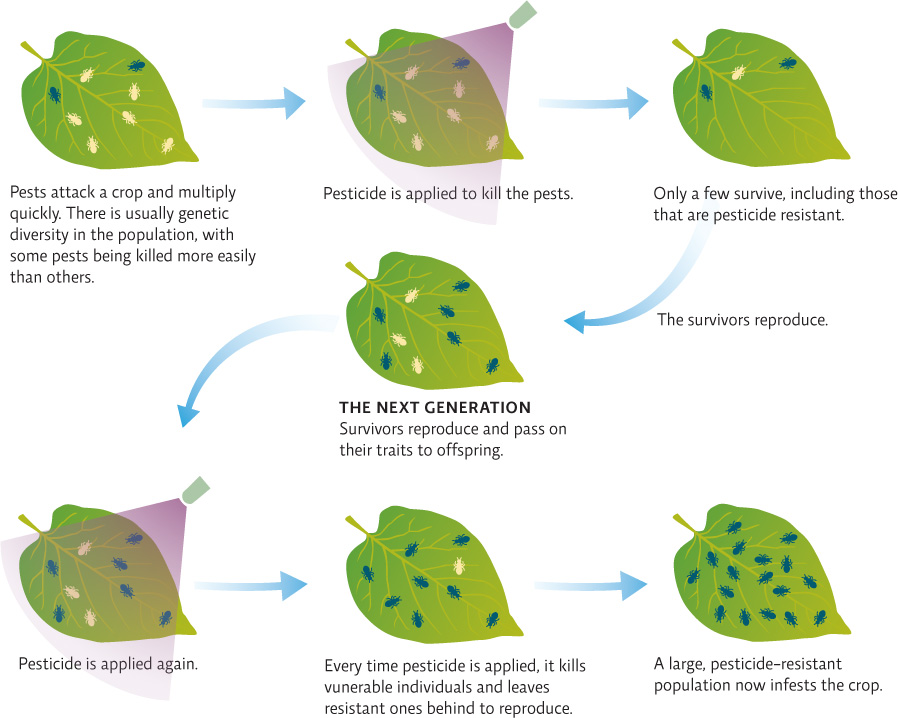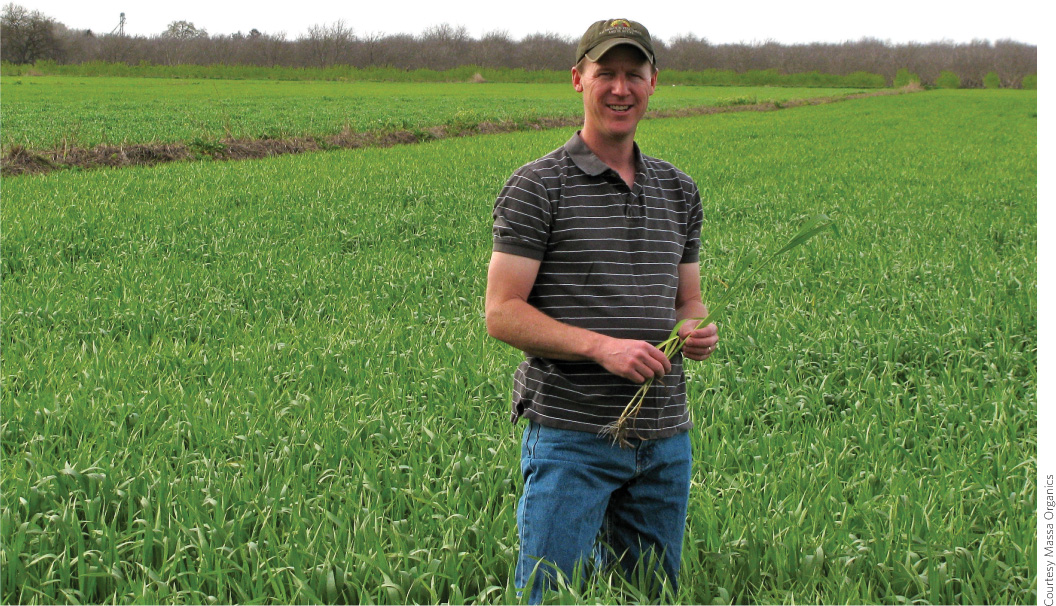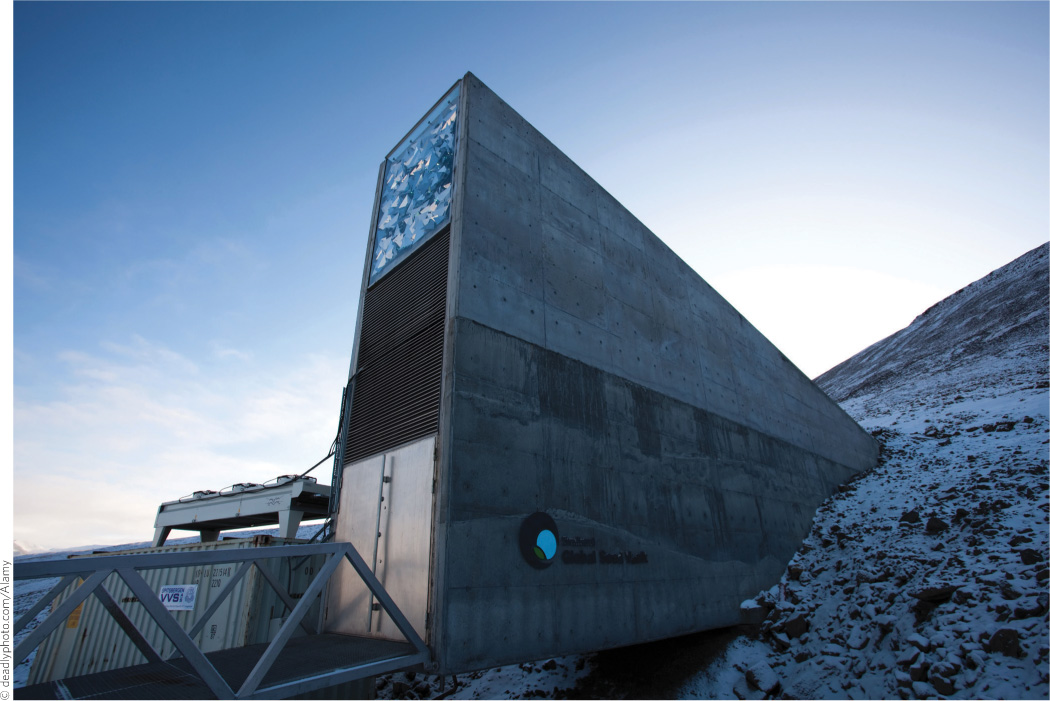Modern industrial farming has advantages and disadvantages.
The changes that helped Greg’s father thrive also ushered in a whole new way of growing crops, known as monoculture farming. Instead of growing a mix of plants, or growing different crops each season, farmers began growing the same single crop year after year. Before long, farms that had been populated by a variety of crops morphed into industrial operations, focused on just one crop. Thus, biodiversity was replaced by specialization, and farm ecosystems that more closely resembled nature were replaced by operations completely dependent on technology.
monoculture
A farming method in which a single variety of one crop is planted, typically in rows over huge swaths of land, with large inputs of fertilizer, pesticides, and water.
“In the 1920s, half of Iowa’s farms produced 20 commodities each,” says Fred Kirschenmann, a Distinguished Fellow at Iowa State University’s Leopold Center for Sustainable Agriculture. “Today 80% of the state’s cultivated land is exclusively corn or soybean. Farming systems that were once supported by complexity and diversity of species have now been replaced by reliance on inputs.” Worldwide, 90% of our food comes from just 15 crop species and 8 species of livestock.
The same monoculture approach has also been applied to rearing livestock. In a concentrated animal feeding operation (CAFO), livestock are raised in confined spaces, with a focus on raising as many animals in a given area as possible. In the case of cattle, they are fed a nutrient-rich diet of grain and soybean, supplemented with some hay; the animals are generally not permitted to graze or roam free. CAFOs are highly productive; they minimize the amount of land that is used. Since about the mid-1900s, high-density feedlot operations like this have been the most common method of raising cattle in the United States. Today, poultry (chickens and ducks) and pigs are also predominantly raised in CAFOs. (See LaunchPad Chapter 30 for more on CAFOs.)
concentrated animal feeding operation (CAFO)
A method in which large numbers of meat or dairy animals are reared at high densities in confined spaces and fed a calorie rich diet to maximize growth.

The advantages of this approach are obvious: A single crop (or type of animal in a confined space) is much easier to manage and to mass produce, and with greater ease comes not only greater efficiency and greater profits but also drastically greater amounts of food for a planet that has never seemed to have enough.
In recent years, however, the disadvantages of industrial agriculture have become equally apparent. For starters, both monocrop agriculture and CAFOs contribute heavily to global warming. Clearing so much land to grow food reduces the amount of carbon that can be sequestered by natural vegetation through photosynthesis. Also, fertilizer and livestock emit greenhouse gases. In fact, according to the UN Food and Agriculture Organization, livestock is responsible for some 18% of anthropogenic greenhouse gases. (See Chapter 21 for more on global warming and climate change.)
Worldwide, 90% of our food comes from just 15 crop species and 8 species of livestock.
In monoculture farming, the crop that is chosen is not necessarily locally adapted. Instead of choosing the crop best suited to the existing ecosystem, farmers focus on the crops with the highest market demand and thus the highest dollar value. Because these crops are not locally adapted, and because the volume of plants grown increased exponentially, the average farm becomes heavily dependent on external inputs—water, pesticides, and fertilizer—added to the farm from outside its own ecosystem.
Fertilizers boost growth because they provide nutrients that plants need, such as nitrogen and phosphorus. (See Chapter 8 for more on nutrient cycles.) And while heavy doses of fertilizer can indeed boost crop production, the excess nutrients (whatever the plants don’t use) can soak into the ground and contaminate the groundwater or be easily washed from fields by rain and modern irrigation practices. The excess, or runoff, enters waterways and can ultimately create hypoxic, or oxygen-poor, conditions that threaten aquatic life. This process, known as cultural eutrophication, has been a significant problem in the United States; nutrient runoff from farms in states within the Mississippi River watershed has created a summertime dead zone in the Gulf of Mexico (see Chapter 15). In addition, synthetic fertilizers are made from fossil fuels (natural gas and, to a lesser extent, petroleum), both of which are in limited supply and are environmentally damaging to extract, process, and ship. INFOGRAPHIC 17.2
cultural eutrophication
Nutrient enrichment of an aquatic ecosystem that stimulates excess plant growth and disrupts normal energy uptake and matter cycles.


How could the disadvantages of fertilizer use be managed to reduce their impact?
The application of less fertilizer would reduce the amount available to runoff and enter water sources. Microfertilization, such as that used in Burkina Faso (see Chapter 16) applies only enough fertilizer (right at the base of the plant) that the plant can use so there is none left over. Planting vegetative buffers around fields and nearby bodies of water would also reduce runoff reaching those bodies of water. Reducing dependence on fertilizer could be addressed by limiting fertilizer use or taking other steps to enrich soil (such as planting crops that add nutrients, rotating crops so different levels of nutrients are pulled out of the soil from year to year, and allowing the soil to lay fallow for a year every so often. [These latter topics are covered later in the chapter but this question provides good food for thought.]
KEY CONCEPT 17.3
Fertilizer use can increase productivity but can degrade soil and contaminate nearby bodies of water.
Monoculture crops are also especially vulnerable to pests or disease: Pest populations can explode when they encounter acres and acres of a suitable crop on which to feed, and a single infestation can wipe out the entire crop because what kills one plant will likely kill them all. To deal with this, farmers have turned to pesticides (many of which are made from petroleum), but this also has proven problematic. To be sure, pesticides kill plant and animal pests and thus dramatically reduce the number of crops lost each year to infestation. But because they are toxic, pesticides also pose a threat to human and ecosystem health. And as scientists have discovered, pest populations can develop pesticide resistance, an unintentional example of artificial selection (see Chapter 11). Herbicide-resistant weeds and insecticide-resistant insects are cropping up all around the world. Such resistance encourages us to employ more drastic measures, in the form of higher doses or more toxic chemicals; as resistance to that next pesticide develops, the cycle repeats itself. It’s like an arms race between humans and pests, with the deck stacked in favor of the pests. INFOGRAPHIC 17.3
pesticide resistance
The ability of a pest to withstand exposure to a given pesticide; the result of natural selection favoring the survivors of an original population that was exposed to the pesticide.
Exposure to a pesticide will not make an individual pest resistant; it will likely kill it. However, if a few pests survive because they happen to be naturally resistant, they will breed and their offspring (most of which are also pesticide resistant) will make up the next generation. Over time, the original pesticide will no longer be effective and will have to be applied at a higher dose or a different pesticide will have to be used.


How could application of a pesticide actually lead to an increase the size of the pest population? (Hint: Think about the predators of the pests.)
Application of a pesticide might increase the size of the pest population by killing the predators that eat the pests. If the pest population rebounds faster than the predator populations, the pest population size could grow larger, having lost the natural population control provided by its predator.
Even water inputs have created problems. It turns out that the use of irrigation can result in soil salinization; as water evaporates from the soil, salts are left behind and eventually become so concentrated that they impede crop growth. And if all that weren’t enough, the colossal machines used to plow endless fields of corn and soybean have compacted the soil, making it harder for plants to take root and grow.
On top of that, the quality of the food itself can also suffer. Several recent studies have shown a decline in the nutrient content of food grown on soils subjected to years of industrial farming. In one of the first such studies, University of Texas researcher Donald Davis compared the nutritional content of 43 fruits and vegetables grown in 1950 to those grown in 1999; he noted a decline in six nutrients (protein, calcium, phosphorus, iron, and vitamins B2 and C). Davis suspects that this is due to the impoverished soil in which the crops are grown.
KEY CONCEPT 17.4
Pesticide use can help fight pests but is toxic to other species, including humans, and can lead to pesticide resistant pest populations.
Another underappreciated consequence of modern monoculture farming is that fewer and fewer varieties of crops are planted. In the past, each region used locally adapted crop varieties developed over hundreds, even thousands, of years by area farmers—crops that were adapted to the local climate, soil conditions, pests, etc. But as independent farmers joined the industrialized food production system, their tendency was to plant the single variety of corn or wheat or rice that was currently the highest producer. This has led to an erosion of genetic diversity, which translates into a loss of the genetic raw material that allows crops to respond to changes such as the arrival of a new fungal pest or a drier climate. (See Chapters 12 and 16 for more on the importance of genetic diversity to agriculture.)
Without a wealth of crop varieties to choose from, plant breeders will have a harder time developing new strains to meet specific needs. The fear is that, if not planted, many plant varieties could be lost forever. Seed banks, such as one located in the high Arctic in Svalbard, Norway, are one solution to this dilemma. There seeds are kept in cold storage, housed in a tunnel carved out of a mountain; even if the power goes out, these seeds will stay frozen. The Svalbard bank holds more than 700,000 varieties of crops from all over the world. Community seed banks and exchanges may be of even more immediate use to local farmers, and many of them are springing up in Asia and Africa.
seed banks
Places where seeds are stored in order to protect the genetic diversity of the world’s crops.
CAFOs come with their own set of problems: They are environmentally taxing and ethically questionable. While the high-grain diets fed to confined animals certainly maximize growth, they are not necessarily good for the animals’ health. Such diets may cause liver and stomach disorders, increased susceptibility to infections, and even death. In addition, crowded living conditions (which some view as inhumane) make CAFO animals more vulnerable to disease, forcing farmers to use heavy doses of antibiotics. Such heavy use contributes to antibiotic resistance, which threatens the health of the animals and humans.
As modern farmers face these enormous challenges (and global warming and energy and water shortages along with them), the story of how we feed ourselves is changing yet again. This time, we may have to consider not just high-tech solutions but look back to the natural world for answers. In searching for a new weapon against the azolla, Raquel found a Japanese rice farmer who was doing just that.

